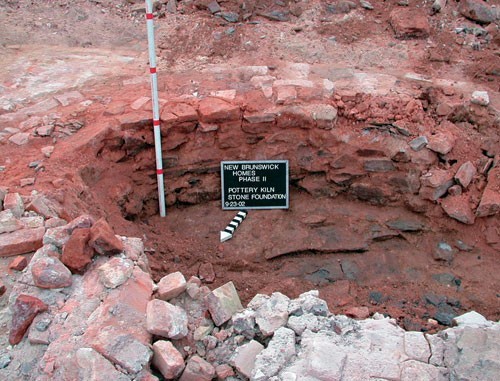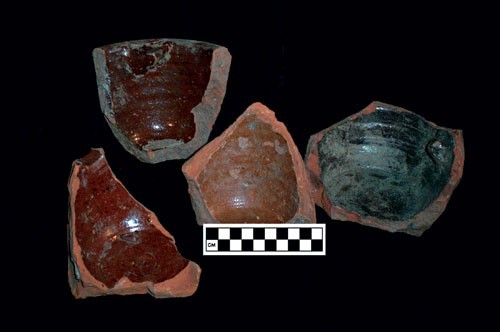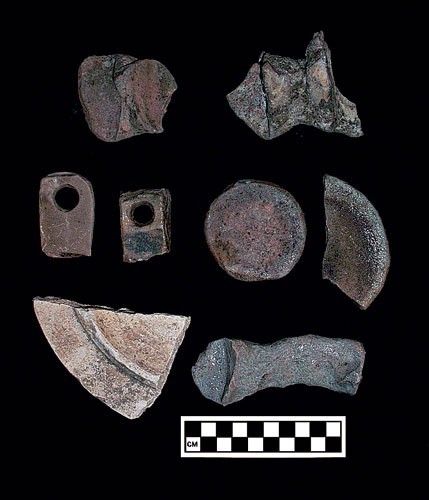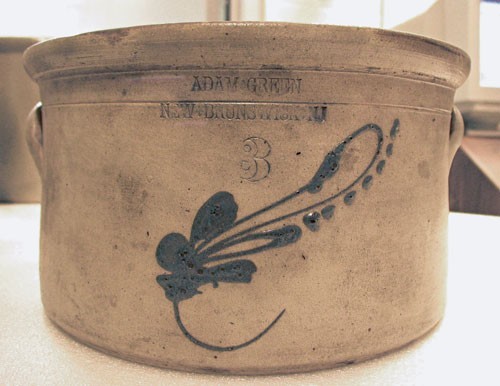
The New Brunswick Stoneware Pottery as depicted in a Sanborn Fire Insurance Map drawn in 1886. The pottery is in the bottom center of the map. The rectangular kiln excavated by the Cultural Resource Consulting Group is at the upper (northern) end of the pottery.

The base of the rectangular kiln showing the remains of three firing chambers.

The foundation of a circular kiln, likely an updraft kiln used in the manufacture of redware and possibly terra cotta, found beneath the rectangular kiln. It predates 1886.

Redware saggers recovered from the fill associated with the circular kiln and likely employed in the manufacture of redware cups and porringers.

Stoneware kiln furniture associated with the rectangular kiln. The top row includes a pair of double-ended pads or spindles. The second row consists of two draw tiles and a pair of caps. The caps still show shadows from the vessels they covered. The third row has a fragmentary plaster mold and a double-ended pad.

Storage jar, New Brunswick, New Jersey, ca. 1870. Salt-glazed stoneware. (Courtesy, Newark Museum, 47.24.) A jar made at the New Brunswick Stoneware Pottery during Adam Green’s tenure. This piece, a three-gallon, large-mouthed jar or crock, is typical of the pottery’s wares. It is marked “Adam Green /New Brunswick, NJ/3.”

Monetta Good, At the Country Auction,1935. (Courtesy, Newark Museum.) The stoneware crock depicted with the rather dour family shows the distinctive floral design, possibly honeysuckle, favored by the New Brunswick Stoneware Pottery.
In recent years New Brunswick, New Jersey, has undergone a major revival. Much of the city’s historic core, particularly those sections nearest the Raritan River, has been redeveloped. Four low-income housing towers constructed in the 1950s near Route 18 were imploded and construction began on a new, mixed-income neighborhood. Although construction of the towers effectively erased most archaeological deposits from the property, portions of the New Brunswick Stoneware Pottery, which operated at this site from about 1862 to 1901, miraculously survived. Archaeological excavation of the pottery site revealed the bases of two kilns and 1,285 related artifacts, providing a glimpse of one of New Jersey’s longest-lived stoneware manufactories.
The New Brunswick Stoneware Pottery traces its genealogy back to Ephraim Mackay’s earthenware pottery established in 1810 at the corner of Liberty and George Streets. By 1850 the operation had expanded its product line and was manufacturing both earthenware and stoneware. In 1862 Elizabeth Mackay, Ephraim’s widow, sold the property to Alfred Buttler. That same year Buttler also acquired New Brunswick’s other pottery, the Price Pottery on Burnet Street. Buttler was a successful local capitalist, known to his contemporaries as one of the area’s leading manufacturers of architectural millwork. By investing in a stoneware manufactory, he was following an uncertain path to riches.
Buttler rapidly consolidated the potteries’ operations and moved the equipment from the Mackay Pottery to the Burnet Street location, the property studied here, in 1866 or 1867.[1] As reported in the 1870 New Jersey Products of Industry report, the pottery employed about twenty people and had three pug mills. It annually produced approximately 3,000 pieces of terra cotta and chimney tops, and 10,000 feet of sewer pipe.[2] In November 1875 Buttler sold the pottery to Charles W. McMullen and Thomas F. Connolly for $25,000. In the next fifteen years the property would be transferred eight more times among five different owners—Thomas F. Connolly; Connolly and a partner, Charles T. Palmer; William Rowland; and, in 1880, Adam Green—evidence of the difficulty of making a profitable living in this trade. During this period, the pottery’s value declined by 50 percent.[3]
Green, the last owner, is listed as a potter in New Brunswick directories from 1866 to 1871 and is reported to have been a salesman for the New Brunswick pottery for seven years before he purchased the operation.[4] Sadly, Green proved unable to meet his mortgage and the property was foreclosed in 1901.
After the pottery closed, the neighborhood rapidly declined. A 1910 newspaper article described the area as “the worst slum area in New Jersey with the exception of those in Atlantic City and Newark.”[5] Nearly fifty years later, in 1958, the New Brunswick Housing Authority acquired the property, demolished the existing buildings and built four low-income housing towers called New Brunswick Homes. By 1998 they too were considered distressed, and the New Brunswick Housing Authority, with funding from the Department of Housing and Urban Development, proposed to demolish the tenements and construct mixed-income townhouse and low-rise units. In August 2002 the towers were demolished and the property was extensively graded.
Because the project was federally funded, the New Jersey Historic Preservation Office requested that an archaeological survey be performed under Section 106 of the National Historic Preservation Act of 1966. The goal was to determine whether archaeological deposits survived and, if so, to characterize them. Initial testing consisted of a series of backhoe trenches—approximately 60–100 feet long, 8 feet wide, and 5–7 feet deep—that were dug across the tract. The testing revealed two areas where potentially significant archaeological remains survived. The first, not discussed here, contained wells and cisterns, mid- and late-nineteenth-century shaft features; the second held remains associated with the New Brunswick pottery.
The area containing the remains of the pottery measured approximately 60 by 45 feet. Using a backhoe, the overlying layers of modern fill were removed to reveal the partially intact kiln floor. Kiln furniture, stoneware vessel fragments and wasters, redware vessels and saggers, roofing tile fragments, and other pottery-related artifacts were scattered across the site. Most of the artifacts were found in an earlier destruction level, presumably relating to the early-twentieth-century demolition of the pottery.
Excavation of the site ultimately revealed the remains of two kilns, one located directly on top of the other. Although both of the kilns were truncated, enough survives of them to make some general statements regarding their function. The uppermost kiln was rectangular in form and was entirely contained within a masonry structure. It is depicted on an 1886 Sanborn Map (fig. 1). The room containing the kiln measured approximately 35 feet long, east to west, and 22 feet wide, north to south. The kiln took up the eastern two-thirds of the structure. The kiln’s base is 19.4 feet long and 15.8 feet wide (fig. 2). There are three firebrick platforms on top of the standard brick base. The platforms are one brick high and were made from light yellow firebricks. The surface of the platforms is covered with highly vitrified slag, a by-product of the salt-glazing process. Each platform is about 11 feet long and 4 feet wide and appears to have been subdivided into eastern and western halves. When the building was demolished, everything but the lowermost level of the kiln was removed.
The rectangular form of the kiln loosely resembles but is larger than the Richards kiln in Trenton excavated by Hunter Research,[6] and appears to have had at least three chambers, rather than a single one, like the Richards kiln. Based on the limited remains at the site, it is challenging to determine whether this kiln was an updraft or downdraft kiln. No clear evidence of a firebox was found at the pottery. The area to the west of the kiln chambers was deeply disturbed by a pipe trench. It is possible that the firebox was once located at this location and the chimney was at the eastern end, although this cannot be stated with certainty.
Immediately underlying the rectangular kiln were the truncated and highly fragmentary remains of a second kiln (fig. 3). All that remained of this earlier kiln was its circular stone-and-brick foundation. Its interior diameter is approximately 12 feet and its exterior diameter is roughly 16 feet. No evidence of the flue system was noted. The area inside the stone wall was full of stone rubble, perhaps placed there to help support the weight of the later kiln erected on the site. Circular kilns (or bottle kilns, depending on their flue configuration) could be either updraft or downdraft, though the former seems more likely here. As the circular kiln is not shown on the 1886 Sanborn Map, it must have been demolished before that date. It is possible that this earlier kiln was used to manufacture redware rather than stoneware, as a small number of redware porringers and saggers were recovered in association with the kiln (fig. 4). Unlike the rectangular kiln, the circular kiln remains had no salt-glaze residue.
The excavators also recovered a variety of kiln furniture: double-ended pads or spindles, crescent pads, sliced pads both wide and narrow, caps, spacers, saddle wads, saggers, and other miscellaneous pieces (fig. 5). The pads are noteworthy for their regularity and thin cross-sections. Most measure at least 7 centimeters in length and almost every pad measured slightly over one centimeter in thickness. They were either cut from blocks of clay using a wire or rolled from lumps of clay with a pin. Similar pads have been found at the Morgan Kiln Site in Cheesequake and the Price Pottery in Sayreville,[7] but the pads from the New Brunswick pottery are much thinner. Twenty-four fragmentary stoneware draw tiles were recovered from the site, all of them pierced. Found nearby were several small fragments of plaster molds from the manufacture of jar or crock lids.
Seven hundred and twenty-one fragments of stoneware vessels were excavated from the vicinity of the kiln. Based on the analysis of sherds, at least 119 individual vessels are present. The most common vessel form was the large-mouthed jar or crock; lids for these jars were numerous. Also recovered were a handful of ink bottles and a pair of spittoons. The New Brunswick pottery, particularly under Buttler’s ownership, was known for its jars and jugs, many of which are marked “A. J. Buttler, New Brunswick.” Jars and jugs are well represented in the collection. The jars came in many sizes, and pieces marked two and three gallons were recovered. Compared to the wide range of vessels recovered at other New Jersey stoneware potteries, the selection of vessels found here is quite narrow. However, it is hard to say whether the types of vessels present reflect the last firing, the stock on hand when the building was demolished, or are truly representative of the wares produced in the pottery’s later years.
Roughly 10 percent of the stoneware fragments are decorated, and all with hand-brushed cobalt blue designs. A few vessels show foliage, flowers, and birds. Several examples also display a distinct flower motif that appears to have been a favorite of the artisans at the New Brunswick pottery. The flower, perhaps honeysuckle, is depicted with a clearly drawn stamen and pistil, the latter represented by a series of dots decreasing in size as they move away from the stem (fig. 6). A similar design, the serial dot pistil, was commonly used by stoneware potters in New England, particularly those at the Norton Pottery in Bennington, Vermont.[8] The collections of the Newark Museum and New Jersey State Museum contain examples of vessels produced at the New Brunswick pottery under its various owners, all of which show this same floral design (fig. 7).
The excavation of the New Brunswick Stoneware Pottery provides a glimpse of a forgotten aspect of New Brunswick’s industrial history. The two kilns and sizable collection of kiln furniture and wasters allow us to better understand the production processes used at later stoneware potteries, while museum collections help better define the range of vessels and decorative forms employed by this pottery. Perhaps most interesting, the site yielded kiln furniture and potter’s tools that have not been recovered from other New Jersey stoneware manufactories, among them a handful of plaster molds and draw tiles. These items may indicate an increasing attention to eYciency among the struggling New Brunswick potters who were trying to compete with a rising tide of inexpensive glass, metal, and mass-produced ceramic containers late in the nineteenth century.
ACKNOWLEDGMENTS
We would like to thank Peter Primavera of the Cultural Resource Consulting Group for encouraging us to share the results of this study. We are grateful for the assistance of William Liebeknecht and Meta Janowitz, who shared their considerable knowledge of early New Jersey stoneware.
M. Lelyn Branin, The Early Makers of Handcrafted Earthenware and Stoneware in Central and Southern New Jersey (Rutherford, N.J.: Fairleigh Dickinson University Press; London: Associated University Presses, 1988), p. 121.
United States, Census Office, “Census of Manufactures, Middlesex County, Products of Industry,” 9th Census, Schedule 4, 1870 (available on microfilm at the New Jersey State Library, Trenton).
Cultural Resource Consulting Group, Highland Park, N.J., “Cultural Resource Investigations, Riverside–New Brunswick Home, Hope VI Project, City of New Brunswick, Middlesex County, New Jersey,” report prepared for New Brunswick Housing Authority, New Brunswick, N.J. (available at the New Brunswick Free Public Library).
Samuel T. Wiley, Biographical and Portrait Cyclopedia of the Third Congressional District of New Jersey, Comprising Middlesex, Monmouth, and Somerset Counties, with an Historical Sketch of Each County (Philadelphia: Biographical Publishing Company, 1896), p. 756.
Clifford B. Ross, unidentified newspaper clipping, ca. 1910, vertical files, New Brunswick Free Public Library, New Brunswick, N.J.
Richard Hunter, “Eighteenth-Century Stoneware Kiln of William Richards Found on the Lamberton Waterfront, Trenton, New Jersey,” in Ceramics in America, edited by Robert Hunter (Hanover, N.H.: University Press of New England for the Chipstone Foundation, 2001), pp. 239–43.
Hunter Research, Inc., Trenton, N.J., “Phase II Archaeological Survey N.J. Route 34 (Cheesequake) Old Bridge Township, Middlesex County, New Jersey, 1996,” pp. 6-2, 6-3, report prepared for Federal Highway Administration and New Jersey Department of Transportation, Bureau of Environmental Analysis, Trenton (available at the New Jersey State Historic Preservation Office, Trenton, N.J.); Louis Berger and Associates, Inc., East Orange, N.J., “Archaeological Investigations at the Sayre and Fisher Brickworks and Price Pottery Site: Harbortowne Waterfront Development, Sayreville, New Jersey,” p. viii-38, 1990 report prepared for Coastal Group, Inc., Colts Neck, N.J., Monmouth County Historical Association Library and Archives, Freehold, N.J.
Cornelius Osgood, The Jug and Related Stoneware of Bennington (Rutland, Vt.: Charles E. Tuttle, 1971), p. 96.
